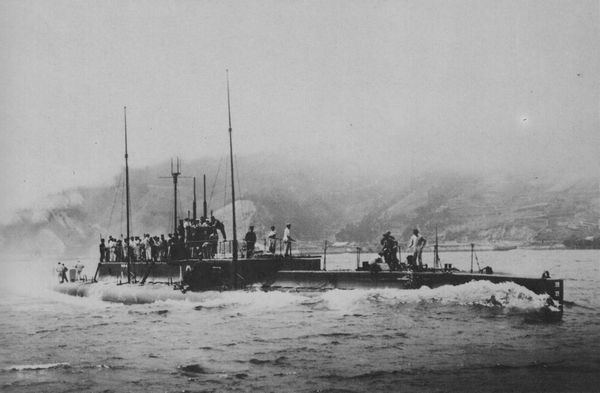Name Kaichū type submarines Built 1917-1944 | In commission 1919-1945 | |
 | ||
Builders Kure Naval ArsenalSasebo Naval ArsenalYokosuka Naval ArsenalKawasaki ShipbuildingMitsui Engineering & ShipbuildingMitsubishi Heavy Industries Subclasses Kaichū I (Ro-11 class)Kaichū II (Ro-13 class)Kaichū III (Ro-16 class)Kaichū IV (Ro-26 class)Toku-Chū/Kaichū V (Ro-29 class)Kaichū VI (Ro-33 class)Sen-Chū/Kaichū VII (Ro-35 class) | ||
The Kaichū type submarine (海中型潜水艦, Kaichū-gata sensuikan) submarines were double-hulled medium sized submarines of the Imperial Japanese Navy during World War II. They were derived from the Kaigun-shiki Chū-gata Sensuikan (海軍式中型潜水艦, Navy Medium Type submarine).
Contents
- Class variants
- Kaich I Ro 11 class
- Kaich II Ro 13 class
- Kaich III Ro 16 class
- Kaich IV Ro 26 class
- Kaich V Toku Ch Ro 29 class
- Kaich VI Ro 33 class
- Kaich VII Sen Ch Ro 35 class
- References
Several variants existed. From 1934 to 1944, the K6 type (Ro-33 Class) and the K7 type (Senchū, Ro-35 Class) were built. They were equipped with a 3.0 inch (76.2 mm) gun and four 53 cm torpedo tubes for ten Type 95 Long Lance torpedoes.
Most of these submarines were destroyed in combat, suffering from Allied anti-submarine warfare measures, and only the Ro-50 survived the war.
Class variants
The Kaichū type submarines were divided into seven classes:
Kaichū I (Ro-11 class)
Project number S7. In 1910s, the Imperial Japanese Navy (IJN) bought a license of Schneider-Laubeuf design submarine. The IJN used the design as model and built the S Type (Schneider Type) submarine, the Ha-9 and Ha-10. The Kaichū I is the submarine which jumboized the S Type submarines.
Kaichū II (Ro-13 class)
Project number S18. The Kaichū II had an increased range compared with the Kaichū I, and the turning torpedo tubes were removed.
Kaichū III (Ro-16 class)
Project number S18. Their project number was the same as in the Kaichū II type submarine, however their performance was improved.
Kaichū IV (Ro-26 class)
Project number S18A. Improved model from the Kaichū III type.
Kaichū V (Toku-Chū, Ro-29 class)
Project number S18B. They were built for economic-warfare role. The IJN official designation of these boats was Special Purpose-Medium Type submarine (特中型潜水艦, Toku-Chū-gata sensuikan).
Kaichū VI (Ro-33 class)
Project number S30. They were planned as a prototype for a mass production submarines in the wartime under the Maru 1 Programme.
Kaichū VII (Sen-Chū, Ro-35 class)
Project number S44. The final design in the Kaichū series. They were equipped with a Freon air-conditioner, because the IJN took into consideration that they were to be active on the equator area too. The official IJN designation of these boats was Medium Type submarine (中型潜水艦, Chū-gata sensuikan), also called for short, Medium Type (中型, Chū-gata) or Submarine-Medium Type (潜中型, Sen-Chū-gata).
The IJN planned to build these boats under the following Naval Armaments Supplement Programmes:
However some of the boats were cancelled and their naval budgets, materials and staffs were transferred to the I-201 class submarines.
